What eats vultures? It turns out that these feathered scavengers, despite their intimidating size and reputation, have their own share of predators. From the skies to the land and even in the murky depths, vultures are not immune to becoming a meal themselves. In this blog post, we will dive into the fascinating world of vulture predators, uncovering the top eight culprits that dare to challenge these majestic birds. So, whether you’re a fan of these winged creatures or simply curious about the circle of life, get ready to be amazed by the audacity of hawks, jackals, snakes, hyenas, jaguars, cheetahs, crocodiles, and even us humans. Let’s explore the wild side of vulture survival, where the hunters become the hunted!
The Predators of Vultures
Despite their imposing stature and reputation as nature’s janitors, vultures are not always at the top of the food chain. From high in the sky to the wild terrains below, these scavenging birds face threats from various predators. A surprising array of creatures, including nimble hawks, cunning jackals, slithering snakes, and opportunistic humans, have found ways to turn the tables on these often misunderstood birds. This section will delve into the top eight predators of vultures, providing intriguing insights into their interactions and survival strategies.
| Predator | Method of Predation |
|---|---|
| Hawks | Use their sharp talons and excellent vision to prey on young vultures. |
| Jackals | Known scavengers, prone to attack vulnerable chicks and eggs in the vulture’s nest. |
| Snakes | Can easily locate a vulture’s nest and consume its eggs. |
| Hyenas | Peaceful coexistence with vultures can turn hostile in times of food scarcity. |
| Jaguars, Cheetahs, Crocodiles | Wild animals with the capacity to prey on adult vultures. |
| Humans | Pose threats due to habitat destruction and hunting. |
While vultures may appear unappetizing to many, in the ruthless world of survival, these birds can indeed fall prey to other animals. After all, in the wild, it’s all about survival, and every creature has a role to play, even the scavenging vultures. As we journey through each predator’s tactics, we’ll discover that the life of a vulture is far more precarious than one might assume.
The Aerial Threat: Hawks
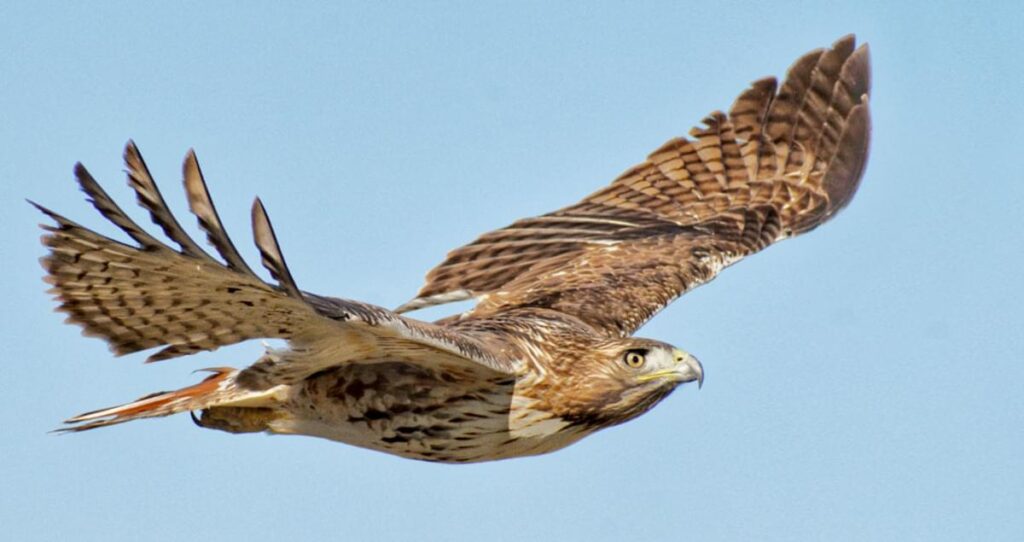
hawks
When you envision the vast expanse of the sky, it’s easy to think of it as a safe haven for the magnificent vultures. However, this is far from the truth. The reality is more like a relentless game of survival, and one of the crucial players in this game are hawks.
Renowned as the masters of the sky, hawks are nature’s formidable hunters. Their keen eyes can spot a prey from miles away and their swift dive speed leaves little room for escape. They are armed with powerful beaks and razor-sharp talons, designed to snatch and tear apart their prey.
Young vultures, still naive and inexperienced in the harsh laws of nature, often fall prey to these skilled predators. The vulture chicks, heavily reliant on their parents for a significant period, are left vulnerable in their nests. It is here, in these nests, that hawks find an easy meal.
“Remember, in the wild, it’s not about the strongest or the fastest, but the one most responsive to change. And in this case, the young vultures are at a disadvantage.”
These brutal encounters are not mere incidents of predation but a grim reminder of the unyielding laws of the wilderness. Every creature, even the mighty vultures, must learn to survive against all odds. The threat from hawks is just one of these myriad challenges that vultures face in their quest for survival.
Read more: Are Bears and Dogs Actually Related? Unveiling the Fascinating Connection
Up next, we delve into the threats vultures face on the ground, including a cunning scavenger known for its opportunistic nature – the jackal.
Jackals: The Ground Threat to Vultures
As we descend from the skies and into the heart of the wilderness, we encounter another formidable predator of vultures: the nimble and cunning jackals. These creatures are more than just scavengers in the animal kingdom. In fact, their adaptability in different environments and changing circumstances gives them an intriguing dual role — both scavenger and predator.
Jackals, much like vultures, are primarily scavengers, feasting on the remains left behind by other predators. They often share the same feeding grounds as vultures, picking through carcasses side by side, in an eerie display of interspecies harmony. Yet, in times of scarcity, this fragile peace shatters, and the jackal’s predatory instincts come alive.
“In scarcity, they are most likely to attack vultures and kill them for food. Younger vultures are more vulnerable to their attack as it takes them time to mature.”
While adult vultures are capable of fending off these attacks with their powerful beaks and talons, the younger ones are not so fortunate. The chicks, still dependent on their parents and lacking fully developed defensive mechanisms, become easy prey for the opportunistic jackals. With their agile bodies and sharp teeth, jackals can swiftly infiltrate vulture nests, turning a once safe haven into a perilous battlefield.
Read more: What Eats Hawks? Discover the Main Hawk Predators and Uncover the Unexpected Predator
It’s a stark reminder of the laws of nature, where survival hinges on adaptability and strength. For the young vultures, the threat from jackals is a harsh initiation into the realities of life in the wild, a test of their ability to survive amidst the ruthless interplay of predator and prey. It is this ceaseless struggle, this dance of life and death, that underscores the precarious existence of vultures in the face of threats like the cunning jackals.
Snakes: The Silent Threat
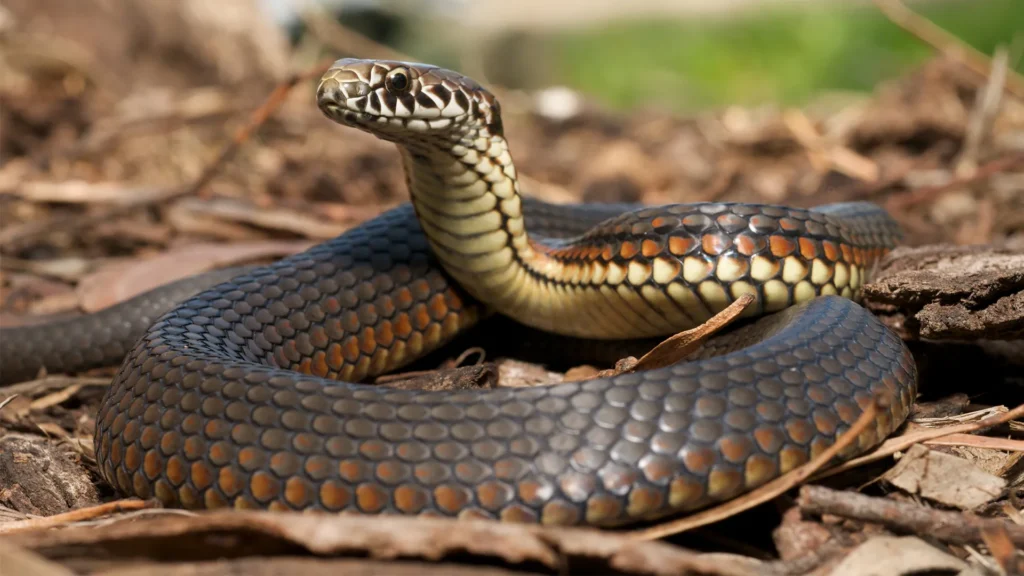
snakes
Imagine a vulture, having survived the predatory swoops of hawks and the cunning advances of jackals, finally returning to its nest, only to find yet another predator lurking in the shadows. This time, it’s a creature that strikes with lightning speed and deadly precision – a snake.
Snakes, with their uncanny ability to navigate treacherous terrains and squeeze into the smallest of crevices, pose a significant threat to vultures, particularly their young chicks and eggs. Their stealthy nature, coupled with an insatiable hunger for eggs and young birds, makes them a force to be reckoned with in the vulture’s fight for survival.
In an unsettling display of nature’s ruthlessness, the serpent inching its way up the tree to a vulture’s nest is a scene that encapsulates the struggle and peril that the vultures face even in their supposed safe haven. A single visit from a hungry snake could decimate an entire generation of vultures before it even has the chance to take flight.
Snakes, such as the egg-eating snake, are specially equipped for this form of predation. Their flexible jaws and long, slender bodies make it possible for them to swallow eggs much larger than their heads. Meanwhile, their ability to navigate the vertical terrains that vultures often choose for their nests allows them to infiltrate these fortresses with alarming ease.
But it’s not just the egg-eating snakes that vultures need to be wary of. Many species of snakes are more than capable of consuming a young vulture chick, a meal that provides a far greater source of nutrition. The stealthy approach of these serpents, combined with their potent venom, can prove to be fatal for the young and vulnerable.
So, even as the vultures soar high in the sky, a silent threat slithers below in the undergrowth, a stark reminder of the relentless circle of life that leaves no room for complacency. In the animal kingdom, survival is a constant game of checks and balances, and for the vultures, the deadly dance with the snakes is just another part of their battle.
Hyenas – The Laughing Scavengers
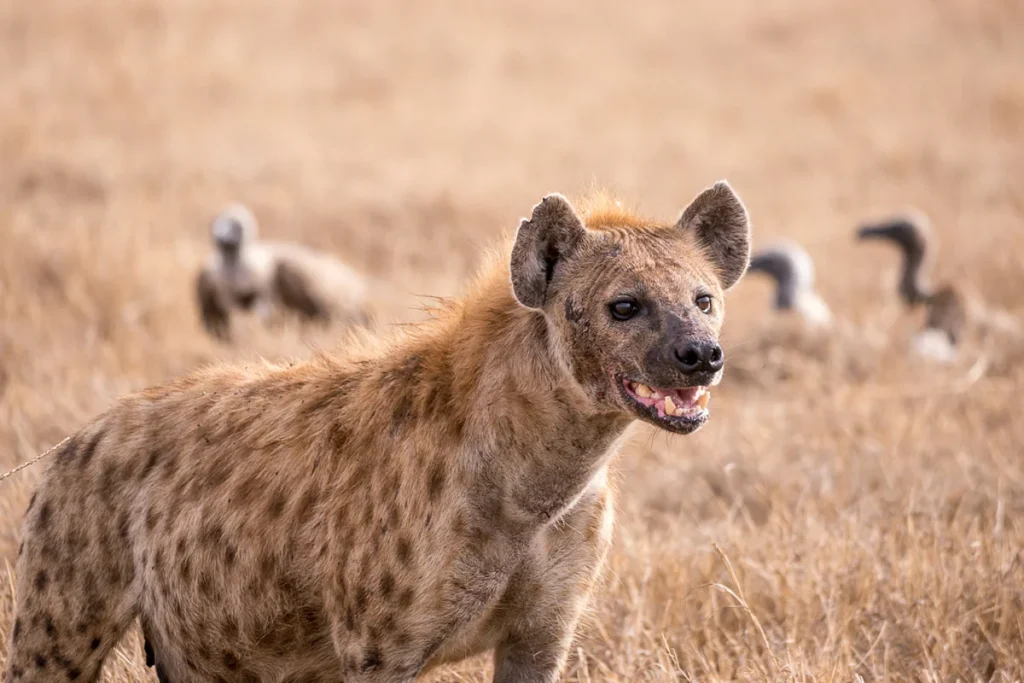
hyena
The vast, untamed wilderness is a battlefield for survival, and amidst this constant struggle, the cunning and tenacious hyenas emerge as formidable adversaries for vultures. These crafty scavengers, much like jackals, often transform into predators when the food supply dwindles, highlighting the raw and relentless competition for sustenance.
Hyenas, with their hunched backs and eerie laughter, are creatures that have learned to adapt to the merciless rules of the wild. In times of plenty, they coexist with vultures, often dining alongside them. However, when the food supply becomes scarce, this seemingly peaceful cohabitation quickly disintegrates. Hyenas, with their powerful jaws capable of crushing bones, pose a significant threat to vultures, especially at shared feeding grounds.
Imagine a barren landscape under the harsh African sun, a carcass lies in the distance, a beacon for scavengers. The vultures, with their keen sight, are the first to arrive, descending in great numbers. But their feast is short-lived. The silence of the wilderness is broken by the chilling laughter of approaching hyenas. The vultures, aware of the impending danger, try to feed as quickly as they can before the hyenas claim their share.
Check out: “Unveiling Mexico’s Majestic Emblem: Meet the Golden Eagle, the National Animal”
Such encounters are not uncommon in the wild. They underscore the relentless cycle of life and death, and the fierce competition for resources that shapes the destinies of both vultures and hyenas. These interactions between vultures and hyenas are a testament to the brutal, yet fascinating dynamics of the wilderness.
The Silent Stalkers: Jaguars
Enter the realm of the jaguars, the silent stalkers of the animal kingdom. As you delve deeper into the wilderness, you will encounter a predator with an uncanny ability to quietly sneak up on its prey. This is the world of the jaguar, a big cat known for its powerful build, lightning speed, and deadly precision. These majestic beasts pose yet another threat to the survival of vultures, specifically the young ones.
Picture this: a cozy vulture nest perched on a cliff or nestled in the hollow of an ancient tree. The parents are out scavenging for food, leaving their young ones behind, hidden from the eyes of predators. Or so they think. For the jaguar, this presents an irresistible opportunity.
The jaguar’s keen eyes spot the nest from a distance. Its stealthy approach, perfected over years of evolution, allows it to get closer without alerting the chicks. What follows next is a quick ascent, a swift pounce, and a tragic end to the young vulture’s life.
This is not a rare occurrence in the wild but a grim reality that emphasizes the vulnerability of vulture chicks. The jaguar’s predation on vulture chicks is a stark reminder of the relentless cycle of life and death in the animal kingdom. The juvenile vultures, still dependent on their parents for protection and sustenance, are left defenseless, making them easy prey for such agile predators.
The survival of vultures in the face of such threats underscores their resilience and adaptability. But it also highlights the crucial role of the adult vultures in protecting their young and ensuring the continuity of their species.
So, next time you read about jaguars, remember, they’re not just the majestic big cats we admire for their strength and agility. They’re also silent stalkers, making the world of vultures a little more perilous.
Cheetahs: The Unseen Threat
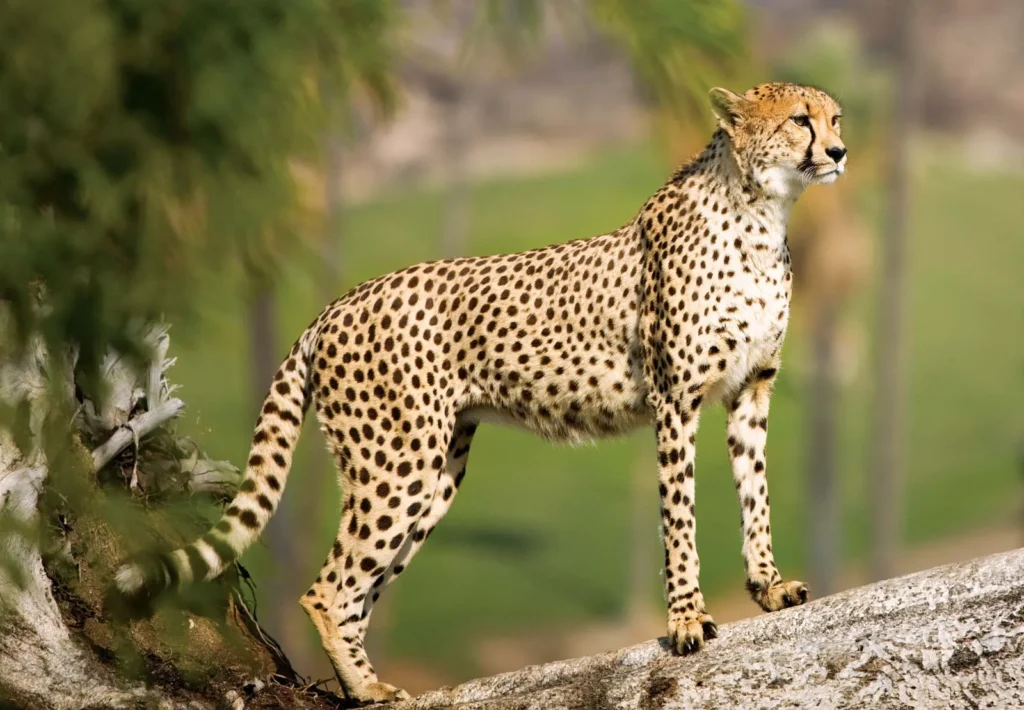
cheetah
Among the myriad threats faced by vultures in the wild, perhaps none is as unexpected as the cheetah. This remarkable creature, renowned for its incredible speed, has been known to turn its sights on vultures when hunger drives it to desperate measures.
As the fastest land animal, the cheetah is endowed with an agility and speed that are simply breathtaking. Capable of reaching speeds of up to 60-70 mph in short bursts, these lithe creatures can cover distances of up to 1,500 ft in a flash. This speed, combined with their stealth, makes them a formidable foe for the unsuspecting vulture.
Interestingly, despite their predatory prowess, cheetahs have a profound vulnerability. Their lightweight frame, while advantageous for speed, leaves them susceptible to being bullied by other wild animals. As such, once they have caught their prey, they must consume it quickly to avoid losing it to stronger, more dominant creatures.
Cheetahs, like many predators, are opportunistic hunters. They primarily focus on smaller prey such as birds and rabbits, but if a vulture happens to be in the vicinity when the cheetah is seeking a meal, the bird could swiftly become the target. This demonstrates the harsh reality of the animal kingdom: survival often comes down to being in the wrong place at the wrong time.
While the vulture’s robust size might deter some predators, a hungry cheetah is not easily intimidated. This further underscores the vulture’s vulnerability in the face of such potent threats.
Thus, even as vultures share the skies and the savannah with a myriad of potential predators, the threat posed by the swift and stealthy cheetah serves as a stark reminder of the dangers that lurk in their environment. From the powerful jaws of hyenas to the swift pounce of a hungry cheetah, the life of a vulture is fraught with perils. But it is these challenges that make the vulture’s survival all the more remarkable.
Crocodiles: The Unseen Danger Lurking in the Depths
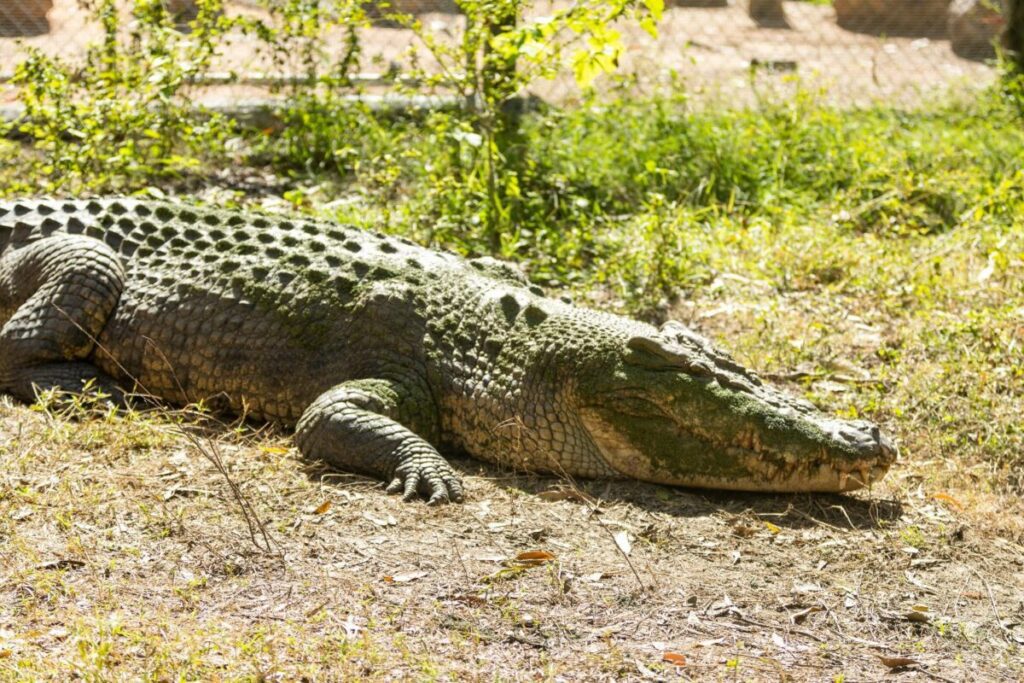
crocodile
Every living creature, vultures included, depend on the life-giving essence of water for survival. However, what appears to be a serene and placid body of water can transform into a perilous death trap for these majestic scavengers. The silent predators of these waters, the crocodiles, pose a significant threat to vultures.
Imagine a vulture, weary from the day’s scavenging, descending to the water’s edge to quench its thirst or cool off in the sweltering heat. The vulture, unaware of the potential danger, enjoys the refreshing embrace of the water. The scene appears calm, belying the deadly predator lurking beneath the surface.
“In the animal kingdom, danger can lurk in the most unsuspecting places.”
From the depths of the water, a crocodile watches. These large reptiles are known for their patience and stealth. Their ability to remain motionless and invisible until the very last moment is what makes them such effective predators. If a vulture strays too close, a crocodile can surge from the water with surprising speed, snatching the unsuspecting bird in its powerful jaws.
While it’s true that crocodiles don’t exclusively prey on vultures, they are opportunistic hunters that won’t turn down an easy meal. Thus, a vulture that ventures too close to the water’s edge is a potential target. This predatory behavior of crocodiles underscores the importance for vultures to remain vigilant at all times, even during seemingly harmless activities such as bathing or drinking.
It’s a stark reminder of the relentless cycle of life and death in the animal kingdom. Even as vultures aid in the circle of life by cleaning up the remains of the dead, they themselves are not exempt from becoming prey. This section serves to highlight that despite their aerial supremacy, vultures face potential danger even from the depths of the water bodies they frequent.
Humans: The Unexpected Threat to Vultures
In the relentless dance of survival, the most unforeseen adversary of vultures turns out to be humans. Although humans do not typically eat vultures due to their diet of decaying matter, they nonetheless pose significant risks to these scavengers. This is a complex issue, one that involves both intentional and unintentional harm.
Take, for instance, the widespread use of pesticides in agriculture. In Africa, livestock often fall prey to wild animals, prompting farmers to lace their carcasses with pesticides in an attempt to ward off these predators. The vultures, in their perpetual quest for sustenance, swoop down on these seemingly harmless carcasses, completely oblivious to the lethal trap they are walking into. Unintended though it may be, this practice results in tragic consequences for the vultures that unknowingly ingest these harmful substances.
However, it’s not just the indirect actions that pose a threat. Some humans, either out of ignorance or desperation, directly target vultures. Despite vultures not being a common source of food for humans, they can be consumed in dire circumstances. This poses a risk to humans as well as vultures. These scavengers, with their robust stomach acid, are capable of digesting toxic elements found in decaying matter. When humans consume vultures, they run the risk of ingesting these toxic substances, which can lead to serious health issues.
Thus, whether through direct consumption or indirect actions, humans contribute significantly to the threats faced by vultures. This highlights the importance of increasing public awareness about the crucial role vultures play in our ecosystem and the need for their protection.
The Perilous Life of Vultures: A Conclusion
It’s a fierce, unforgiving world out there in the wild, particularly if you’re a vulture. From the moment of their first breath, these scavenging birds find themselves in a constant struggle for survival. They face a myriad of dangers – some seen, others unseen.
Just imagine, a young vulture, freshly hatched, unaware that its life is about to be a whirlwind of challenges. It is reliant on its parent, vulnerable, and waiting to be claimed by hawk-eyed predators like hawks or cunning jackals. And let’s not forget the threat posed by the sly snakes that stealthily slither their way into nests, eyeing the precious eggs.
Life doesn’t get any easier as they grow. The expansive wilderness becomes a battlefield where only the strongest survive. Food scarcity can turn typically peaceable scavengers like hyenas into fierce competitors. Even the mighty jaguars and swift cheetahs don’t shy away from seizing an opportunity to prey on adult vultures.
“In the wild, every day is a test of strength and endurance. The vultures’ life is no exception.”
Then there are the crocodiles, lurking beneath the placid water surfaces, ready to snatch an unwary vulture. And not to mention, the most unpredictable predator of all – humans. From the indirect harm caused by the use of pesticides to the direct consumption in desperate times, we pose a significant risk to these birds.
Understanding these threats is not merely about knowing what eats vultures. It’s about realising the fragile balance of our ecosystems, where every life, no matter how seemingly insignificant, plays a critical role. And it’s about fostering a sense of responsibility towards the protection and conservation of these creatures.
As we plunge deeper into the complexities of the natural world, it becomes clear that vultures, like many other wildlife species, need our attention and care. Recognising the threats they face is the first step in this long journey of conservation. Let us remember that every life is precious and deserves a fair chance at survival.
Some predators of vultures include hawks, owls, snakes, jackals, hyenas, jaguars, crocodiles, and other wild animals.
Yes, vultures have natural enemies such as hawks, owls, snakes, jackals, hyenas, jaguars, and crocodiles.
Animals like hawks, owls, snakes, jackals, hyenas, jaguars, and crocodiles can prey on young vultures.
Humans can harm vultures intentionally or unintentionally, such as by using pesticides on livestock carcasses, which can poison the vultures.

